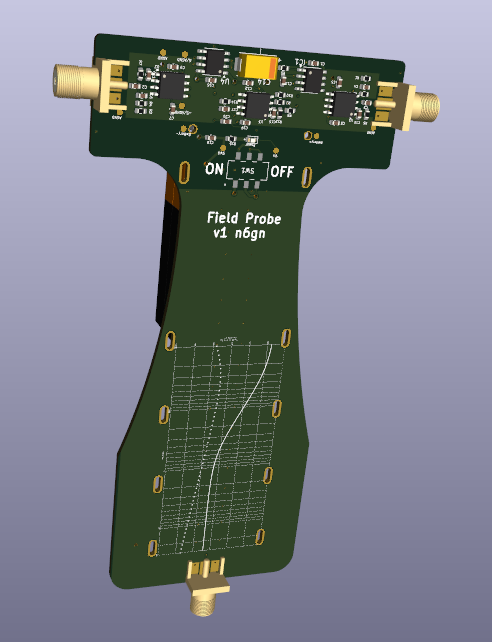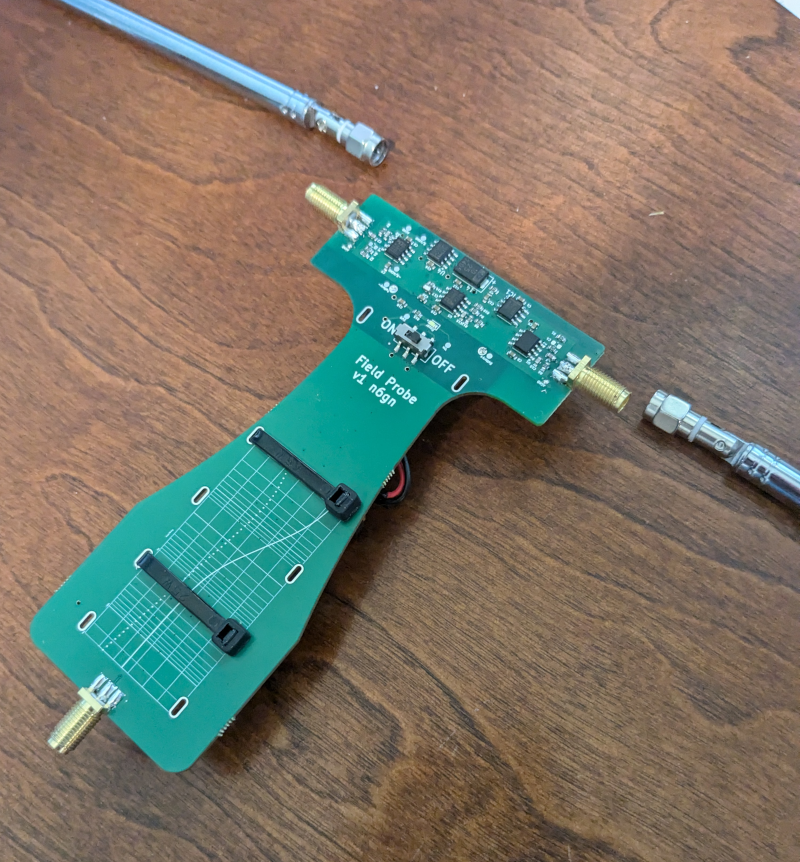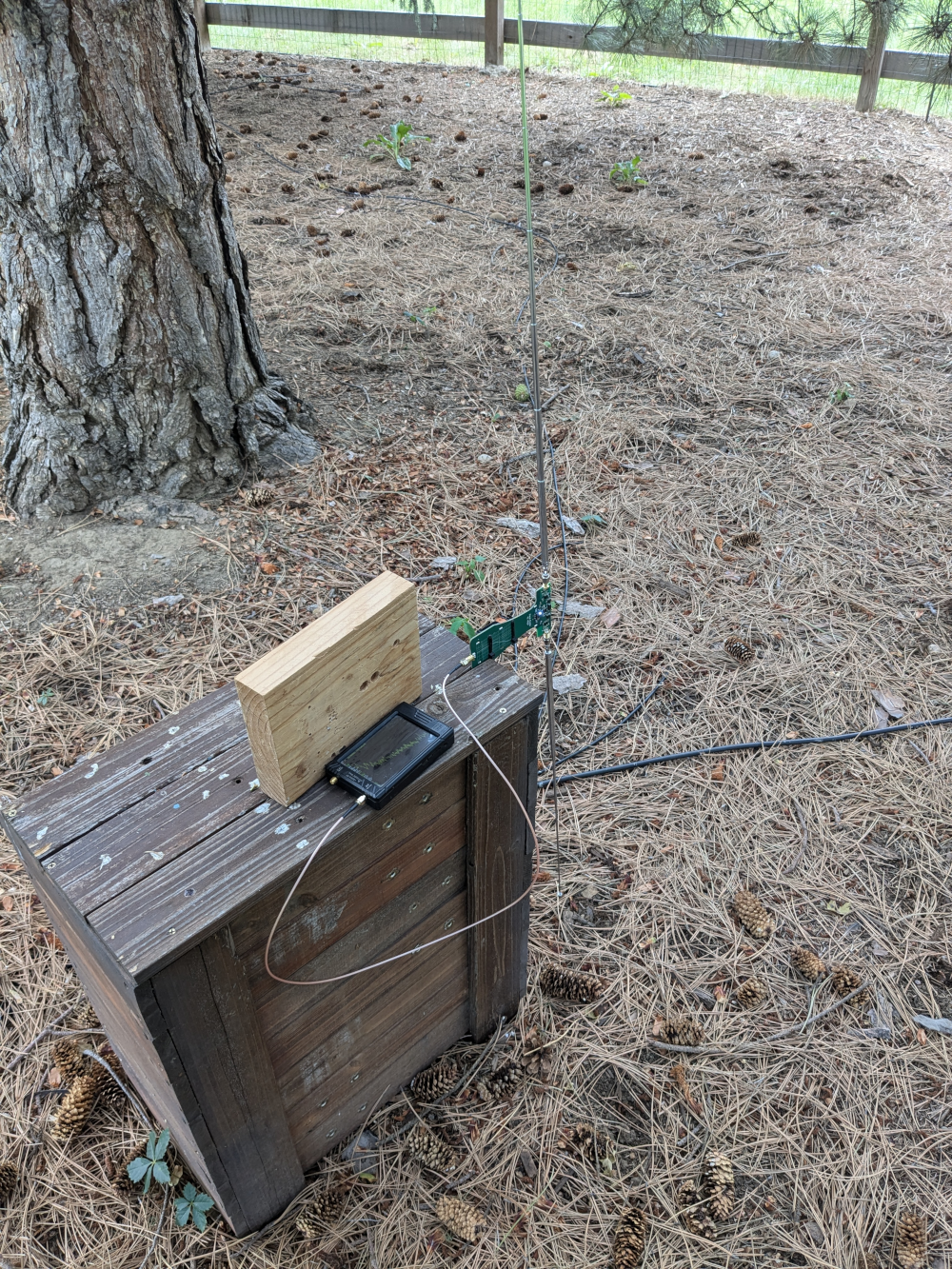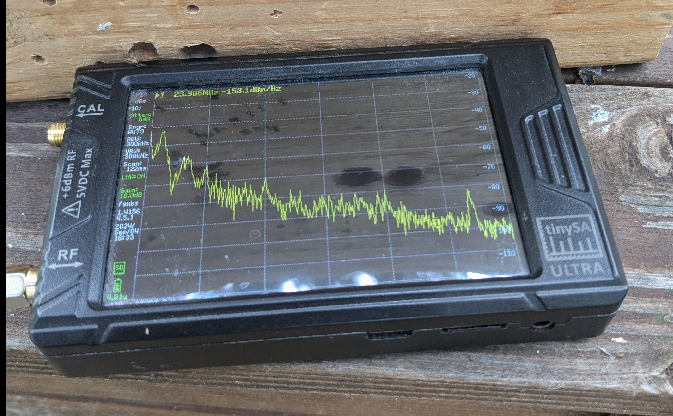Test
Verify that the test points marked, Vp measure as marked.
For better quick viewing of the
design, download the Kit file from the Source Link below, unzip it and
drop the .sch or .pcb file onto KiCanvas
from
a web browser. This
should permit examination of the current schematic and PCB layout.
As an alternative, install KiCad, download the FP Source file (an
archive), open KiCad and select "Unarchive" from its File: menu.
This should bring up the entire design, both schematic and PCB and
allow viewing as well as modification.
Use
When used with the TinySA Ultra BW is set to 300 kHz for a 0-30 MHz
span resulting in a 10*log10(3e5) = 55 dB offset such that kTB will
display as -174 + 55 = -119 dBm. The TinySA can be set to display
Marker noise power directly in dBm/Hz.
A starting point for settings might be:
- 300 kHz RBW,
- LNA off,
- manual attenuation set to 0,
- external gain set to 10 dB to adjust for the gain inside the FP
A first purpose of this probe is to identify areas for siting a
permanent receive antenna system with regard to minimizing local
noise sources. This involves surveying potential candidate mounting
locations for minimum unwanted, often near-field, noise sources. To
the degree that a user has any degree of freedom locations that
appear better or worse may be identified. As a reference
methodology, setting the telescoping monopoles to .5m each and
holding the FP vertically polarized 2m above the earth seems a
reasonable reference orientation.
Once a likely antenna site is selected on the basis of minimum
noise within the sub-spectrum of interest between approximately 1
kHz and 200 MHz that site may be further examined by seeking to
identify sensitivity of the noise level measured to polarization and
azimuth. This may best be done by focusing on the signal-to-noise
ratio (SNR) of a propagated signal, e.g. a NIST Time/Frequency
standard station or other easily visible signal coming and changing
the FP orientation to maximize SNR.
Because the FP has high axial ratio, because it predominantly
linearly polarized along the axis of the monopoles, and because
other sources of signal ingress have been eliminated by the high
CMRR of the design, it is possible to get a high degree of nulling
of a linearly polarized interferer which compromises the SNR of the
desired signal. In this way, seeking to find a polarization and
azimuth the optimizes not signal strength but SNR a better
understanding of preferred orientation for a permanent installation
may be discovered. This type of "noise nulling" can produce
impressive improvements in SNR in situations where there is only a
single interferer. In some situations this is many 10's of dB.
Sources of elliptically polarized interference may need to be
mitigated with a more complex system such as the Polarimeter
described elsewhere. If there are multiple interferers presenting
similar magnitudes even though neither may be eliminated a best
compromise for communications SNR may be found.
As a handheld tool it is very useful to examine SNR as
polarization and azimuth are varied. The device has high axial
ratio, that is, an incoming vertically polarized wave can easily
be nulled by going to horizontal polarization. Sometimes
local and near-field noise results in highest SNR of DX signals
occurring at neither of these polarizations, even recognizing that
there is often significant decrease in levels due to earth
absorption when oriented horizontally which also tends to push the
arrival angle overhead.
For many uses, there is no need to know an antenna factor.
Relative measurements of noise and SNR may accomplish all that is
needed. For comparative measurement though it can be useful to know
antenna factor. Antenna Factor for the Field probe in a 50 ohm
environment with antenna set to 1m tip-tip and measured at 150 MHz
calculated from a Jupyter Notebook created by Claude gives:
============================================================
MEASUREMENT SUMMARY
============================================================
Parameter Value
Frequency 150.0 MHz
Wavelength 1.999 m
Horizontal Separation 2.0 m
Antenna Heights 2.0 m
Direct Path Length 2.000 m
Reflected Path Length 4.472 m
Measured S21 -16.30 dB
Electric Field 101.42 dBμV/m
Received Voltage 90.18 dBμV
Antenna Factor 11.24 dB/m
AF (theoretical, free space) 23.76 dB/m
============================================================
The value at every frequency may be obtained by examining the
measured response from the input to the output and adding it.
Measured in a 50 ohm environment the frequency response is as
shown below:
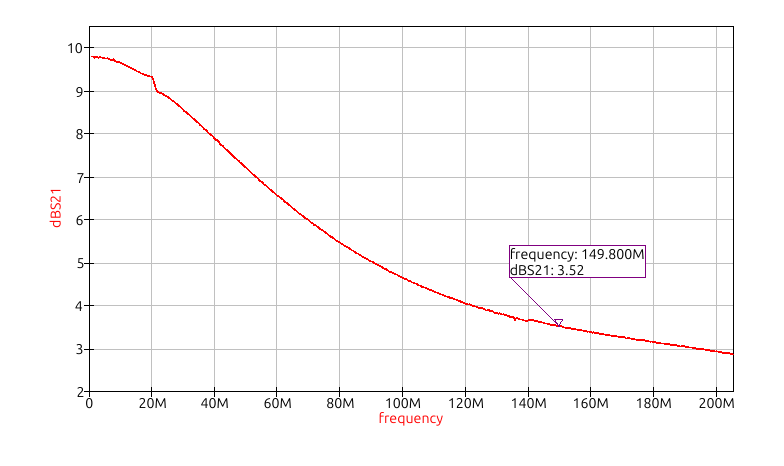
and shows a 3.5 dB gain at the 150 MHz calibration frequency.
The value at each frequency needs to be added to the Antenna Factor
above. Because the probe's preamplifier presents a very high
impedance to the 1m antenna, there should be little mismatch
adjustment required for the probe.
The same can not be said for the reference antenna.
When questioned about this:
"Is it not true that for the approach shown in Amplifier Gain Correction
Guide it is necessary to maintain very good match to the reference
antenna in order to know what the incident field is? Because the match
far from resonance is so poor, mismatch error can be very difficult to
measure. It may be that antenna modeling will be necessary to arrive at
a correct AF?"
